Hao Li
Jack
IGGT: Instance-Grounded Geometry Transformer for Semantic 3D Reconstruction
Oct 26, 2025Abstract:Humans naturally perceive the geometric structure and semantic content of a 3D world as intertwined dimensions, enabling coherent and accurate understanding of complex scenes. However, most prior approaches prioritize training large geometry models for low-level 3D reconstruction and treat high-level spatial understanding in isolation, overlooking the crucial interplay between these two fundamental aspects of 3D-scene analysis, thereby limiting generalization and leading to poor performance in downstream 3D understanding tasks. Recent attempts have mitigated this issue by simply aligning 3D models with specific language models, thus restricting perception to the aligned model's capacity and limiting adaptability to downstream tasks. In this paper, we propose InstanceGrounded Geometry Transformer (IGGT), an end-to-end large unified transformer to unify the knowledge for both spatial reconstruction and instance-level contextual understanding. Specifically, we design a 3D-Consistent Contrastive Learning strategy that guides IGGT to encode a unified representation with geometric structures and instance-grounded clustering through only 2D visual inputs. This representation supports consistent lifting of 2D visual inputs into a coherent 3D scene with explicitly distinct object instances. To facilitate this task, we further construct InsScene-15K, a large-scale dataset with high-quality RGB images, poses, depth maps, and 3D-consistent instance-level mask annotations with a novel data curation pipeline.
Character Mixing for Video Generation
Oct 06, 2025Abstract:Imagine Mr. Bean stepping into Tom and Jerry--can we generate videos where characters interact naturally across different worlds? We study inter-character interaction in text-to-video generation, where the key challenge is to preserve each character's identity and behaviors while enabling coherent cross-context interaction. This is difficult because characters may never have coexisted and because mixing styles often causes style delusion, where realistic characters appear cartoonish or vice versa. We introduce a framework that tackles these issues with Cross-Character Embedding (CCE), which learns identity and behavioral logic across multimodal sources, and Cross-Character Augmentation (CCA), which enriches training with synthetic co-existence and mixed-style data. Together, these techniques allow natural interactions between previously uncoexistent characters without losing stylistic fidelity. Experiments on a curated benchmark of cartoons and live-action series with 10 characters show clear improvements in identity preservation, interaction quality, and robustness to style delusion, enabling new forms of generative storytelling.Additional results and videos are available on our project page: https://tingtingliao.github.io/mimix/.
Learning to Decide with Just Enough: Information-Theoretic Context Summarization for CDMPs
Oct 02, 2025Abstract:Contextual Markov Decision Processes (CMDPs) offer a framework for sequential decision-making under external signals, but existing methods often fail to generalize in high-dimensional or unstructured contexts, resulting in excessive computation and unstable performance. We propose an information-theoretic summarization approach that uses large language models (LLMs) to compress contextual inputs into low-dimensional, semantically rich summaries. These summaries augment states by preserving decision-critical cues while reducing redundancy. Building on the notion of approximate context sufficiency, we provide, to our knowledge, the first regret bounds and a latency-entropy trade-off characterization for CMDPs. Our analysis clarifies how informativeness impacts computational cost. Experiments across discrete, continuous, visual, and recommendation benchmarks show that our method outperforms raw-context and non-context baselines, improving reward, success rate, and sample efficiency, while reducing latency and memory usage. These findings demonstrate that LLM-based summarization offers a scalable and interpretable solution for efficient decision-making in context-rich, resource-constrained environments.
Learning to Generate Object Interactions with Physics-Guided Video Diffusion
Oct 02, 2025Abstract:Recent models for video generation have achieved remarkable progress and are now deployed in film, social media production, and advertising. Beyond their creative potential, such models also hold promise as world simulators for robotics and embodied decision making. Despite strong advances, however, current approaches still struggle to generate physically plausible object interactions and lack physics-grounded control mechanisms. To address this limitation, we introduce KineMask, an approach for physics-guided video generation that enables realistic rigid body control, interactions, and effects. Given a single image and a specified object velocity, our method generates videos with inferred motions and future object interactions. We propose a two-stage training strategy that gradually removes future motion supervision via object masks. Using this strategy we train video diffusion models (VDMs) on synthetic scenes of simple interactions and demonstrate significant improvements of object interactions in real scenes. Furthermore, KineMask integrates low-level motion control with high-level textual conditioning via predictive scene descriptions, leading to effective support for synthesis of complex dynamical phenomena. Extensive experiments show that KineMask achieves strong improvements over recent models of comparable size. Ablation studies further highlight the complementary roles of low- and high-level conditioning in VDMs. Our code, model, and data will be made publicly available.
WoW: Towards a World omniscient World model Through Embodied Interaction
Sep 26, 2025Abstract:Humans develop an understanding of intuitive physics through active interaction with the world. This approach is in stark contrast to current video models, such as Sora, which rely on passive observation and therefore struggle with grasping physical causality. This observation leads to our central hypothesis: authentic physical intuition of the world model must be grounded in extensive, causally rich interactions with the real world. To test this hypothesis, we present WoW, a 14-billion-parameter generative world model trained on 2 million robot interaction trajectories. Our findings reveal that the model's understanding of physics is a probabilistic distribution of plausible outcomes, leading to stochastic instabilities and physical hallucinations. Furthermore, we demonstrate that this emergent capability can be actively constrained toward physical realism by SOPHIA, where vision-language model agents evaluate the DiT-generated output and guide its refinement by iteratively evolving the language instructions. In addition, a co-trained Inverse Dynamics Model translates these refined plans into executable robotic actions, thus closing the imagination-to-action loop. We establish WoWBench, a new benchmark focused on physical consistency and causal reasoning in video, where WoW achieves state-of-the-art performance in both human and autonomous evaluation, demonstrating strong ability in physical causality, collision dynamics, and object permanence. Our work provides systematic evidence that large-scale, real-world interaction is a cornerstone for developing physical intuition in AI. Models, data, and benchmarks will be open-sourced.
A Multi-Scale Graph Neural Process with Cross-Drug Co-Attention for Drug-Drug Interactions Prediction
Sep 18, 2025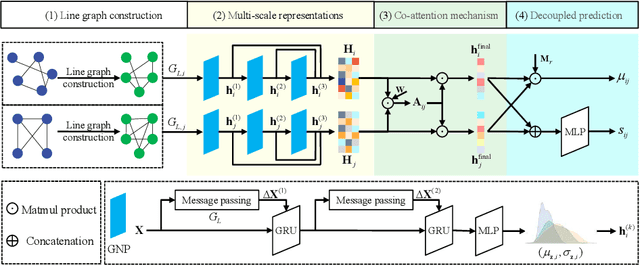
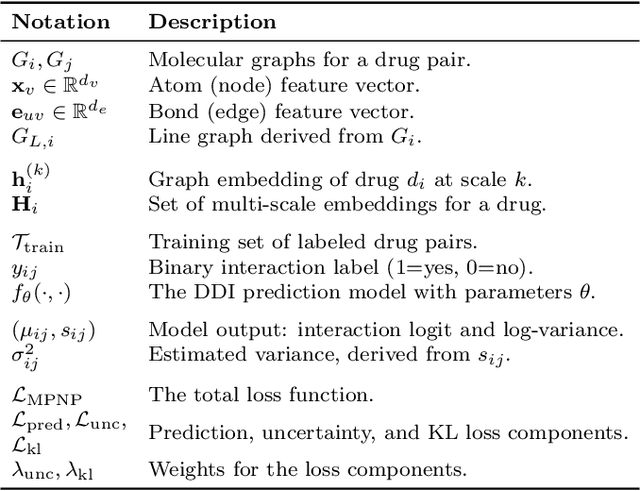
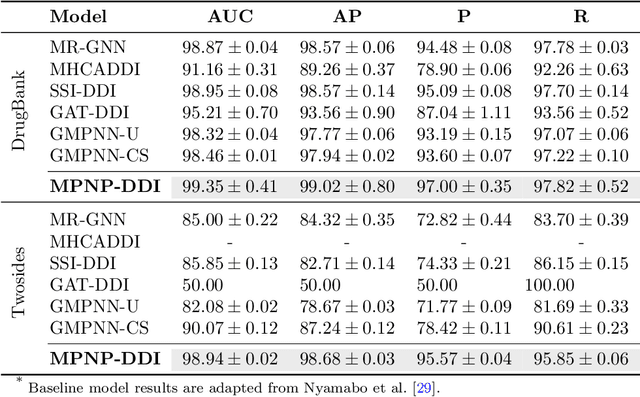
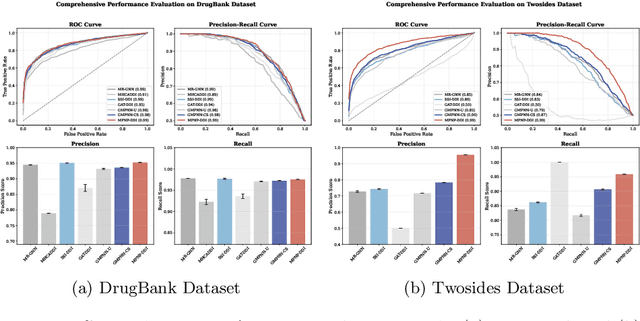
Abstract:Accurate prediction of drug-drug interactions (DDI) is crucial for medication safety and effective drug development. However, existing methods often struggle to capture structural information across different scales, from local functional groups to global molecular topology, and typically lack mechanisms to quantify prediction confidence. To address these limitations, we propose MPNP-DDI, a novel Multi-scale Graph Neural Process framework. The core of MPNP-DDI is a unique message-passing scheme that, by being iteratively applied, learns a hierarchy of graph representations at multiple scales. Crucially, a cross-drug co-attention mechanism then dynamically fuses these multi-scale representations to generate context-aware embeddings for interacting drug pairs, while an integrated neural process module provides principled uncertainty estimation. Extensive experiments demonstrate that MPNP-DDI significantly outperforms state-of-the-art baselines on benchmark datasets. By providing accurate, generalizable, and uncertainty-aware predictions built upon multi-scale structural features, MPNP-DDI represents a powerful computational tool for pharmacovigilance, polypharmacy risk assessment, and precision medicine.
SynBench: A Benchmark for Differentially Private Text Generation
Sep 18, 2025



Abstract:Data-driven decision support in high-stakes domains like healthcare and finance faces significant barriers to data sharing due to regulatory, institutional, and privacy concerns. While recent generative AI models, such as large language models, have shown impressive performance in open-domain tasks, their adoption in sensitive environments remains limited by unpredictable behaviors and insufficient privacy-preserving datasets for benchmarking. Existing anonymization methods are often inadequate, especially for unstructured text, as redaction and masking can still allow re-identification. Differential Privacy (DP) offers a principled alternative, enabling the generation of synthetic data with formal privacy assurances. In this work, we address these challenges through three key contributions. First, we introduce a comprehensive evaluation framework with standardized utility and fidelity metrics, encompassing nine curated datasets that capture domain-specific complexities such as technical jargon, long-context dependencies, and specialized document structures. Second, we conduct a large-scale empirical study benchmarking state-of-the-art DP text generation methods and LLMs of varying sizes and different fine-tuning strategies, revealing that high-quality domain-specific synthetic data generation under DP constraints remains an unsolved challenge, with performance degrading as domain complexity increases. Third, we develop a membership inference attack (MIA) methodology tailored for synthetic text, providing first empirical evidence that the use of public datasets - potentially present in pre-training corpora - can invalidate claimed privacy guarantees. Our findings underscore the urgent need for rigorous privacy auditing and highlight persistent gaps between open-domain and specialist evaluations, informing responsible deployment of generative AI in privacy-sensitive, high-stakes settings.
Understanding Prompt Management in GitHub Repositories: A Call for Best Practices
Sep 15, 2025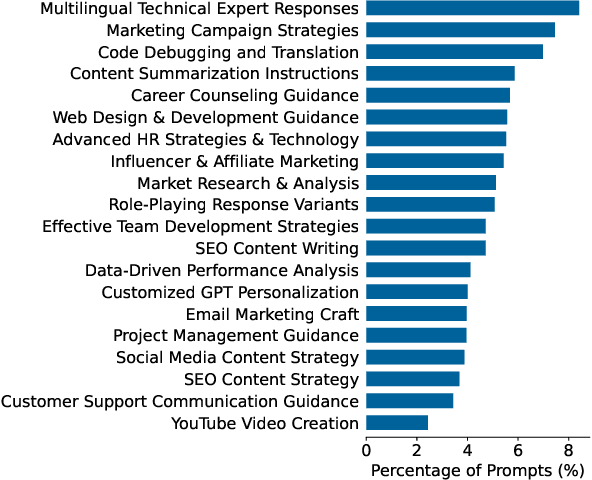

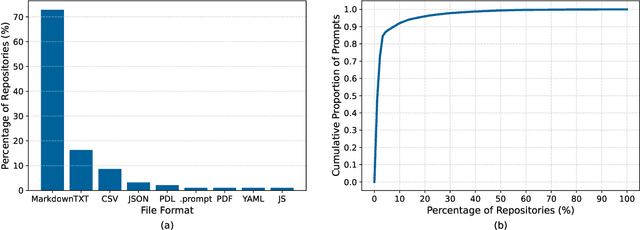

Abstract:The rapid adoption of foundation models (e.g., large language models) has given rise to promptware, i.e., software built using natural language prompts. Effective management of prompts, such as organization and quality assurance, is essential yet challenging. In this study, we perform an empirical analysis of 24,800 open-source prompts from 92 GitHub repositories to investigate prompt management practices and quality attributes. Our findings reveal critical challenges such as considerable inconsistencies in prompt formatting, substantial internal and external prompt duplication, and frequent readability and spelling issues. Based on these findings, we provide actionable recommendations for developers to enhance the usability and maintainability of open-source prompts within the rapidly evolving promptware ecosystem.
Can Understanding and Generation Truly Benefit Together -- or Just Coexist?
Sep 11, 2025



Abstract:In this paper, we introduce an insightful paradigm through the Auto-Encoder lens-understanding as the encoder (I2T) that compresses images into text, and generation as the decoder (T2I) that reconstructs images from that text. Using reconstruction fidelity as the unified training objective, we enforce the coherent bidirectional information flow between the understanding and generation processes, bringing mutual gains. To implement this, we propose UAE, a novel framework for unified multimodal learning. We begin by pre-training the decoder with large-scale long-context image captions to capture fine-grained semantic and complex spatial relationships. We then propose Unified-GRPO via reinforcement learning (RL), which covers three stages: (1) A cold-start phase to gently initialize both encoder and decoder with a semantic reconstruction loss; (2) Generation for Understanding, where the encoder is trained to generate informative captions that maximize the decoder's reconstruction quality, enhancing its visual understanding; (3) Understanding for Generation, where the decoder is refined to reconstruct from these captions, forcing it to leverage every detail and improving its long-context instruction following and generation fidelity. For evaluation, we introduce Unified-Bench, the first benchmark tailored to assess the degree of unification of the UMMs. A surprising "aha moment" arises within the multimodal learning domain: as RL progresses, the encoder autonomously produces more descriptive captions, while the decoder simultaneously demonstrates a profound ability to understand these intricate descriptions, resulting in reconstructions of striking fidelity.
F1: A Vision-Language-Action Model Bridging Understanding and Generation to Actions
Sep 09, 2025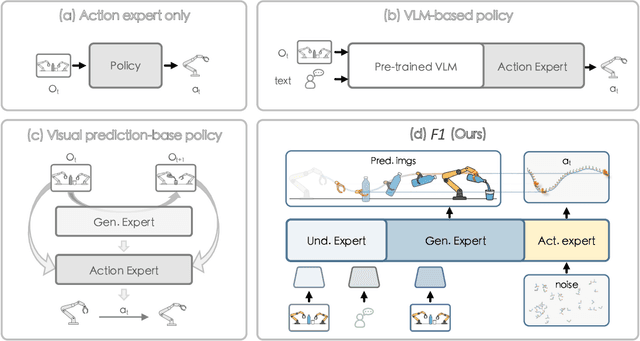

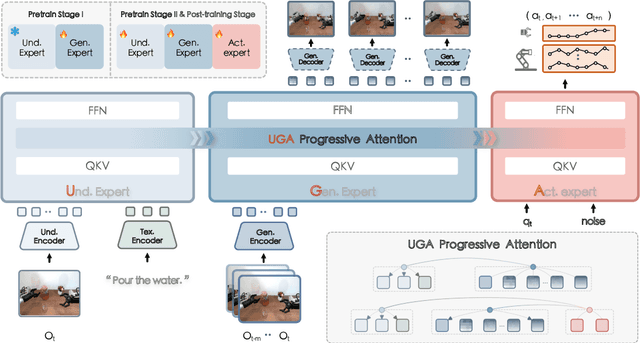

Abstract:Executing language-conditioned tasks in dynamic visual environments remains a central challenge in embodied AI. Existing Vision-Language-Action (VLA) models predominantly adopt reactive state-to-action mappings, often leading to short-sighted behaviors and poor robustness in dynamic scenes. In this paper, we introduce F1, a pretrained VLA framework which integrates the visual foresight generation into decision-making pipeline. F1 adopts a Mixture-of-Transformer architecture with dedicated modules for perception, foresight generation, and control, thereby bridging understanding, generation, and actions. At its core, F1 employs a next-scale prediction mechanism to synthesize goal-conditioned visual foresight as explicit planning targets. By forecasting plausible future visual states, F1 reformulates action generation as a foresight-guided inverse dynamics problem, enabling actions that implicitly achieve visual goals. To endow F1 with robust and generalizable capabilities, we propose a three-stage training recipe on an extensive dataset comprising over 330k trajectories across 136 diverse tasks. This training scheme enhances modular reasoning and equips the model with transferable visual foresight, which is critical for complex and dynamic environments. Extensive evaluations on real-world tasks and simulation benchmarks demonstrate F1 consistently outperforms existing approaches, achieving substantial gains in both task success rate and generalization ability.
 Add to Chrome
Add to Chrome Add to Firefox
Add to Firefox Add to Edge
Add to Edge